Forbidden fruit: How to make the most of seasonal figs
Ripe, succulent figs aren’t always easy to find in the UK, so when you do find them you need to make the most of them. Pete Dreyer shares his five favourite recipes to make sure your hard-earned figs don’t go to waste
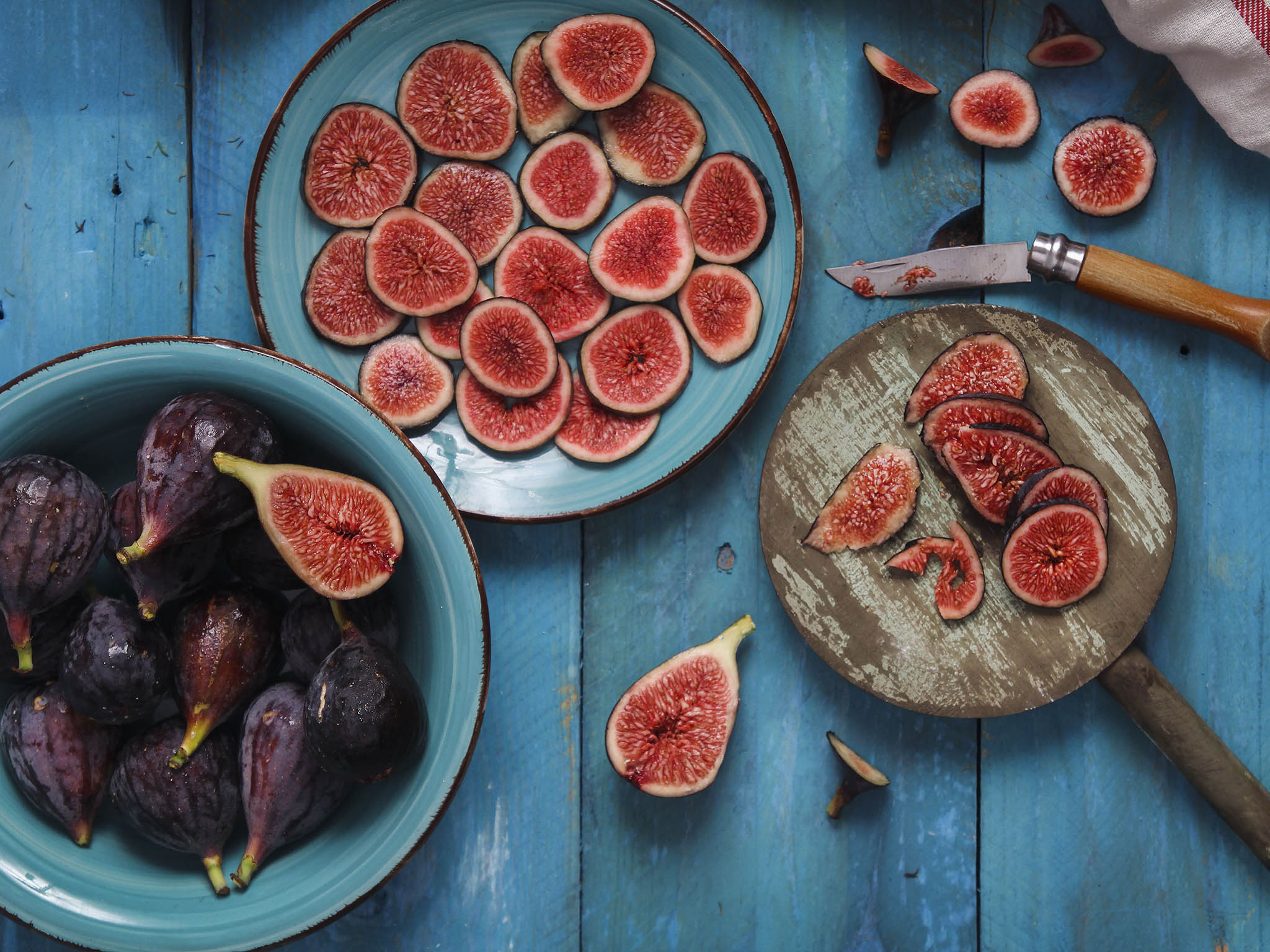
Your support helps us to tell the story
From reproductive rights to climate change to Big Tech, The Independent is on the ground when the story is developing. Whether it's investigating the financials of Elon Musk's pro-Trump PAC or producing our latest documentary, 'The A Word', which shines a light on the American women fighting for reproductive rights, we know how important it is to parse out the facts from the messaging.
At such a critical moment in US history, we need reporters on the ground. Your donation allows us to keep sending journalists to speak to both sides of the story.
The Independent is trusted by Americans across the entire political spectrum. And unlike many other quality news outlets, we choose not to lock Americans out of our reporting and analysis with paywalls. We believe quality journalism should be available to everyone, paid for by those who can afford it.
Your support makes all the difference.Is there any fruit quite as hedonistic as the fig? The royal purple exterior that gives way to sweet, gooey innards – it’s almost as if someone specifically created it to be the ultimate decadence. In fact, the fig has been tempting us since the beginning of time, depending on who you believe. In his Sistine Chapel fresco, Michelangelo painted a fig tree at the centre of the Garden of Eden, which suggests that Adam and Eve actually traded eternal life for a fig.
I’ve always wondered who would doom the human race for the sake of an apple – certainly no-one I want to know – but I can forgive them for choosing the fig. If you dangle a ripe fig in front of me and tell me not to eat it, I don’t care how omnipotent you are; I’m probably eating the fig.
There was a time when the UK was an impossible place to find good figs. The fruit stops ripening as soon as it’s been plucked from the tree, which means that it rarely reaches these shores in perfect condition, arriving either woefully underripe or ravaged by too many days in the back of a lorry.
British figs are a thing now thanks to some clever souls in the south, and in particularly good summers they may be worth seeking out as they will be much fresher than their overseas counterparts.
Otherwise, go for Turkish or Mediterranean figs – anything else will have travelled too far to be any good.
Good figs should have a slight give to them and a slight wobble to the stem – you want them to be softening but nowhere near mushy. Figs that travel a long way to get here will often be picked too early, so look out for signs of under ripeness – shiny, taut skins, firm flesh and milky sap weeping from the stem. If the skins look a bit dull and worn, or even slightly wrinkled, that’s a good sign! Once you’ve found your source, here are five fantastic fig recipes to inspire you into action.
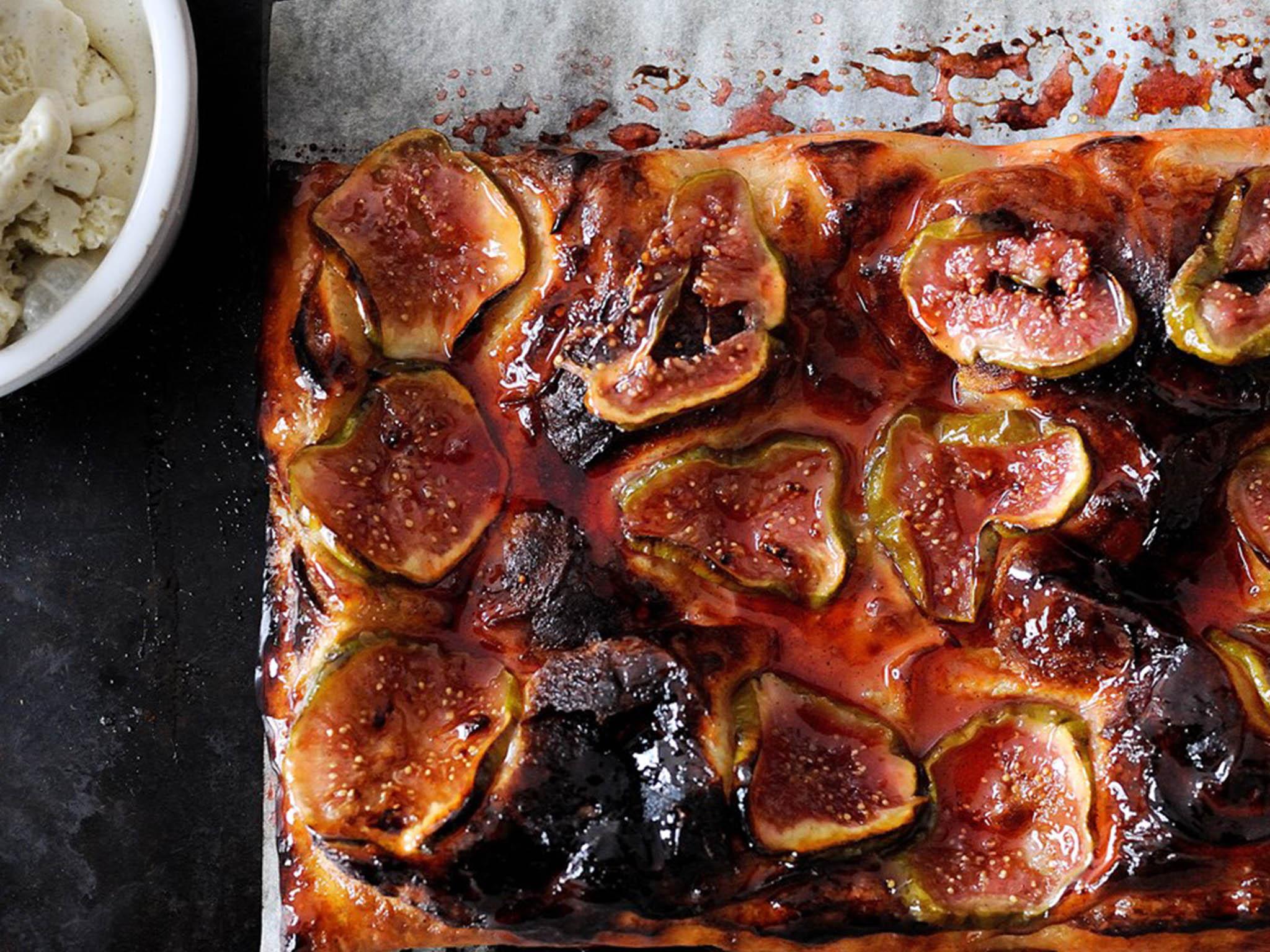
Figs are fantastic in desserts, but their rich sweetness can be a bit overwhelming if not balanced with something else. Chef Tom Aikens caramelises the figs with icing sugar, adding a nutty, toasty depth to the sweetness, and the accompanying cinnamon ice cream cuts through, mellowing the richness. Caramel, buttery pastry and ice cream is a tried and tested combination, and this fig tart is typical of Tom’s cooking, taking classic techniques and recipes – in this case a tarte Tatin – and tweaking them to create something new and exciting.
Fig tarte fine
400g of puff pastry
160g of figs
icing sugar for dusting
cinnamon powder for dusting
Crème pâtissière
150ml of milk
½ vanilla pod, split and seeds scraped
30g of caster sugar
2 egg yolks
20g of plain flour
Cinnamon ice cream
300ml of milk
300ml of double cream
2 vanilla pods, split and scraped, seeds reserved
2 cinnamon sticks
250g of caster sugar
6 egg yolks
1 tsp cinnamon powder
For the cinnamon ice cream, place the milk and cream into a pan with the vanilla beans and cinnamon sticks. Bring this up to a low heat until it starts to steam. Remove the pan from the heat, and leave for 5 minutes to infuse. In a bowl, mix the egg yolks with the sugar, cinnamon powder and reserved vanilla seeds from the pods, then whisk for 3-4 minutes.
Pour the infused milk into the bowl with the egg mix, and whisk these together. Place the mixture back into the pan, stirring with a wooden spoon on a low heat for 5-8 minutes until thick. Once thick, tip into a clean bowl straight away to cool. Leave the cream mixture at room temperature for 5 minutes, stirring occasionally. Then, place in the fridge to cool.
Place the cream mixture into an ice cream maker to churn, or place in the freezer to set. If you are placing this in your freezer it will take longer to set, and you will need to keep stirring every 10 minutes or so until it has frozen. For the crème pâtissière, put the milk and vanilla pod into a pan and bring up to a slow simmer. In a mixing bowl, cream the sugar with the egg yolks and whisk until white. Add the flour and stir well, then slowly pour on the hot milk, whisking vigorously.
Place the mixture back in the pan on a medium heat and bring the mixture up to a simmer, stirring with a wooden spoon - the cream should begin to thicken. Cook for 2-4 minutes, continually stirring, then pass the cream through a fine sieve into a bowl. Cover the crème pâtissière with cling film and leave to cool.
To begin the fig tart, reheat the oven to 220ºC/gas mark 7 with the baking tray heating inside. Take the puff pastry out of the fridge and spread with the crème patissere. Slice the figs 2mm thick and lay them on top of the cream. Dust the figs in icing sugar all over until well covered, and sprinkle with a little cinnamon powder. Place the tart straight on the hot tray in the oven so the bottom will cook instantly and not be soggy. Bake the fig tart for 20-25 minutes until golden. Serve hot with the cinnamon ice cream.
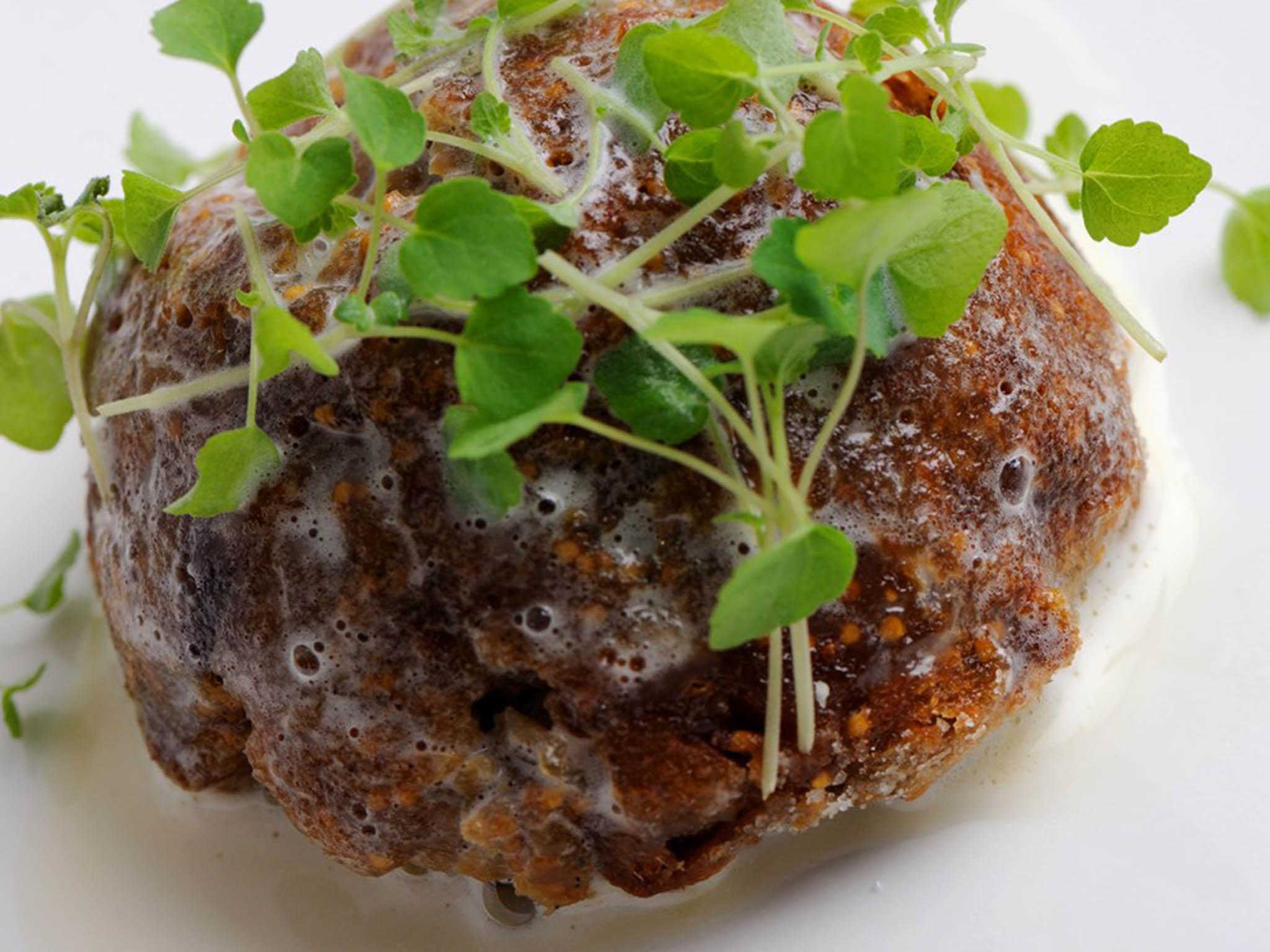
There are few chefs in the world that can match Simon Rogan’s technical brilliance, and his trailblazing food has been hugely influential in the UK food scene. This mousse is effectively a soufflé, and a pretty straight-forward one at that compared to some of Simon’s more innovative recipes. This recipe is a great option if you have some under or overripe figs lying around – Simon mixes his with dried figs as well as orange and vanilla, so you can get away without perfectly ripe fruit.
Fig soufflé
350g of dried figs, chopped
150g of fresh figs, chopped
¼ orange, zested
60ml of double cream
1 vanilla pod, halved
6g of arrowroot
3 eggs, separated
40g of caster sugar
Ramekins
25g of butter
50g of caster sugar
Heat the oven to 170°C/Gas mark 3. Butter 4 ramekins and dust them with caster sugar. Put the dried and fresh figs in a saucepan, add the zest of the orange, cream and scrape in the vanilla seeds.
Stir in the arrowroot and cook on a low heat until the mixture thickens slightly. Remove from the heat and cool. Combine the mixture with the egg yolks. Whisk the whites in a mixer until soft peaks have formed. Add the sugar in batches while whisking to make a firm meringue.
Fold the meringue into the fig mixture and fill the prepared ramekins. Bake for 15-20 minutes, until the soufflés have risen evenly. Leave to cool slightly, then serve.
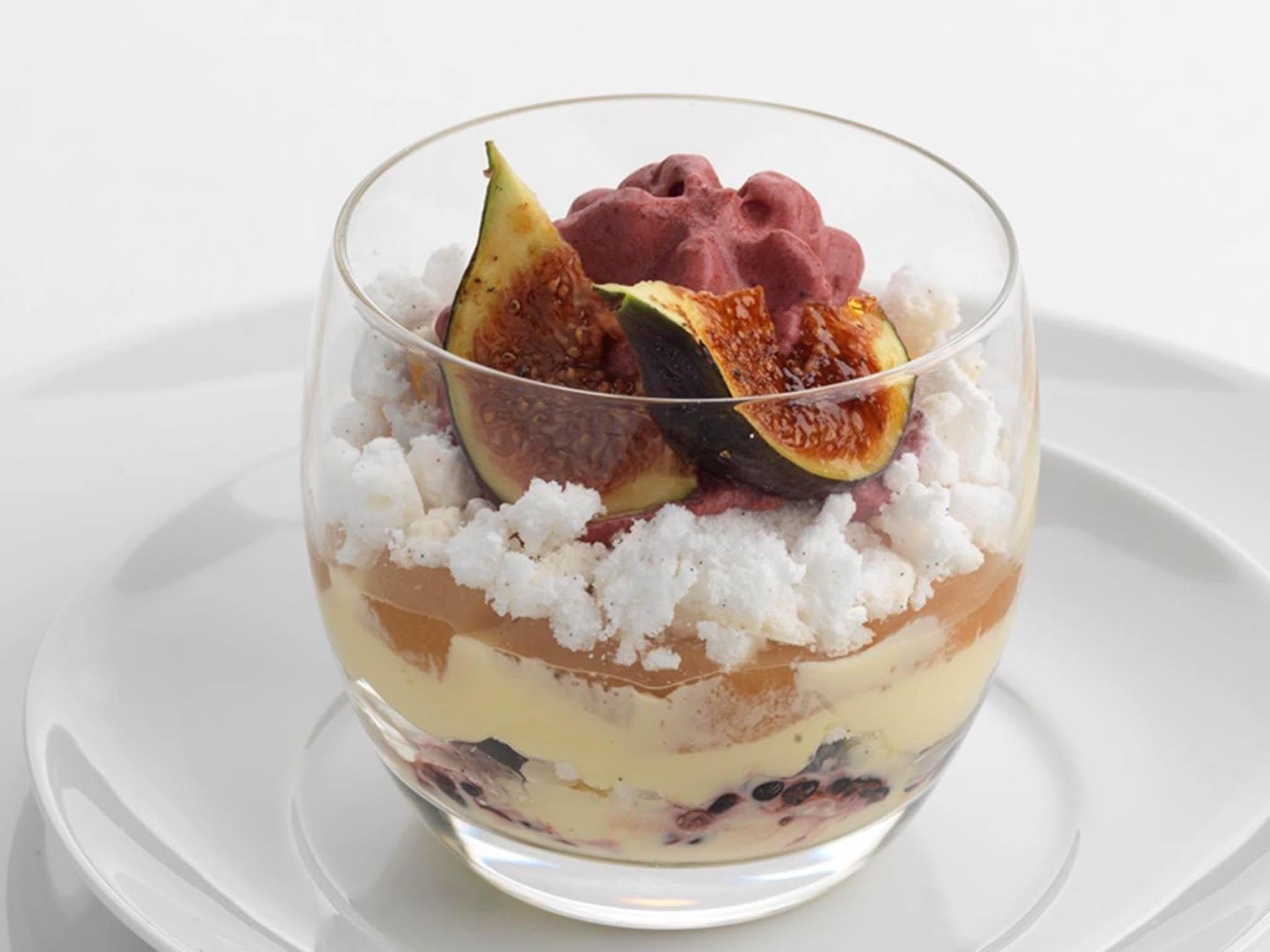
Eton Mess is always a fantastic crowd-pleaser, and you can make it as rustic or as fancy as you like depending on the occasion. As chef and proprietor of the superb Peat Inn in Fife, Geoffrey Smeddle naturally goes for the latter, and pairs figs with blackberries and poached pears to create a nice autumnal fruit medley. Eton Mess is typically a sweet dessert, but Geoffrey whips up a lemon curd to temper the sweetness of the meringue and fruit, and if you can get blackberries that still have a hint of sharpness they’ll bring an extra depth of flavour to proceedings.
Lemon curd
100ml of lemon juice
2 eggs
50g of caster sugar
50g of butter
Meringue
2 egg whites
125g of caster sugar
1 pinch of salt
½ vanilla pod, split and seeds removed
Poached pears
2 Comice pears
4 Earl Grey tea bags
700ml of water
150g of caster sugar
Blackberries
2 punnet of blackberries
1 tbsp of caster sugar
1 dash of creme de mere, optional
Glazed figs
4 fresh figs
icing sugar for dusting
For the lemon curd, combine the lemon juice, sugar and eggs in a bowl. Set the bowl over a pan of gently simmering water and whisk continuously until a thick ribbon forms. Continue to whisk while slowly adding the butter in small amounts. Once the butter is completely incorporated into the mix, allow to cool slightly before transferring into a piping bag with a 1cm nozzle.
For the poached pears, combine the tea, sugar and water in a pan and stir to dissolve. Place the pan over a medium heat and bring to a simmer. Remove from the heat and allow to infuse for 30 minutes. Peel, core and cut the pears into 4 wedges. Remove the tea bags and add the pears to the pan, reheat until simmering. Remove the pan from the heat and allow the pears to cool in the liquid. Store the pears in the liquid until required.
For the meringue, whisk the egg whites, vanilla and a pinch of salt until medium peaks form. Slowly sprinkle in the sugar and continue to whisk until stiff and glossy. Preheat the oven to 90˚C. Line a baking tray with baking paper. Spread the meringue in a thin layer across the baking tray and place into the oven for 1 ½ to 2 hours until lightly golden.
Wash the blackberries and add half to a small pan with the sugar and 50ml of water. Warm the blackberries over a medium heat and gently crush until the mixture starts to boil. Remove from the heat and push through a fine strainer to remove the seeds. Cut the other punnet of blackberries in half, add the creme de mere and strained liquid and macerate the berries until required.
Trim the stems from the figs and cut into 4 wedges. Dust with icing sugar and glaze with a blow torch (or under a hot grill) until a deep golden brown colour. Place on a baking tray and warm through in the oven for a few minutes. To arrange the Eton mess, place some of the blackberries at the base of each glass and pipe over the lemon curd to cover. Slice the pears finely and arrange on top of the curd. Next, crush the meringue and sprinkle over the pears. Top with the warm figs and a dusting of icing sugar. Serve.
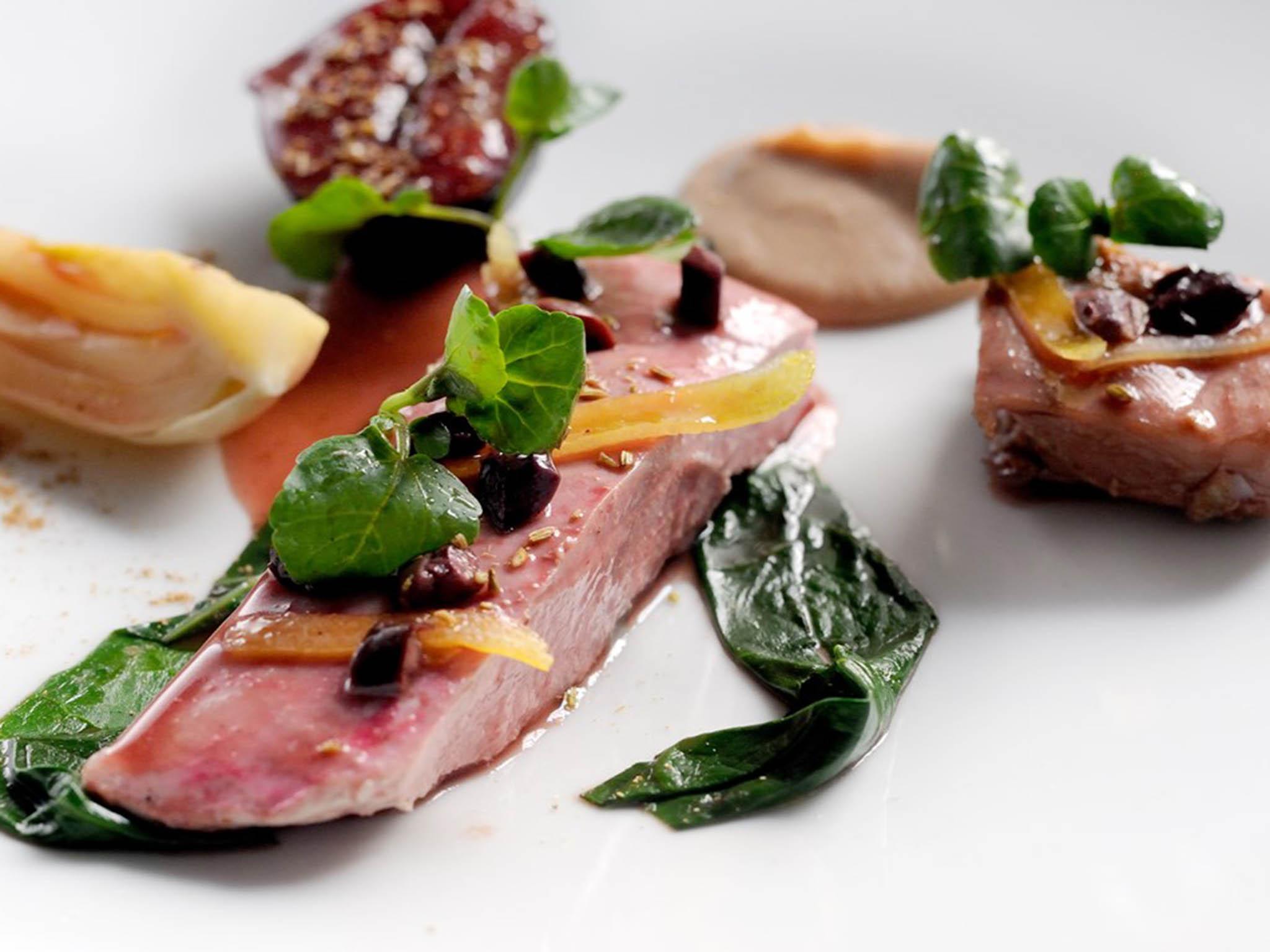
Having worked under Marco Pierre White, Tom Aikens, Marcus Wareing and Raymond Blanc in the course of his career, Agnar Sverrisson has a serious pedigree, and it’s no wonder his restaurant Texture has been so successful since it opened a decade ago. Figs are just as comfortable in savoury dishes as they are in desserts, and Agnar’s duck dish shows off the combination of sweet figs and gamey duck breast, throwing a hit of aniseed into the fray for good measure. This is a Michelin star-level dish, so there are a lot of individual processes, but most of it can be done well ahead of time and reheated closer to serving.
Duck confit
4 duck legs
1l duck fat
20g of rock salt
1g of Chinese five-spice powder
Fig purée
500g of dried figs
200ml of water
200ml of red wine
200ml of port
Fennel powder
100g of fennel seeds
Duck sauce
650g of duck bones
75ml of red wine
1000ml of brown chicken stock
1g of xanthan gum
2g of salt
28ml of red wine vinegar
1 garlic clove
2g of thyme leaves
1g of fennel seeds, toasted
Confit fennel
1 fennel bulb
2 tbsp of olive oil
20ml of Pernod
20ml of Noilly Prat
1 star anise
salt
Confit figs
4 black figs
200ml of red wine, reduced by half
Fig and fennel purée
20ml of olive oil
250g of fennel, finely chopped
50ml of water
1 pinch of salt
50ml of milk
Duck
4 duck breasts
salt
black pepper
Swiss chard
500g of Swiss chard, stems removed
Rub the salt and five spice into the duck legs and leave overnight in the fridge. Heat the oven to 140°C/Gas mark 1. Wipe the excess salt off the legs and put into an oven proof dish. Cover with the duck fat and place into the oven for 2 hours 30 minutes. Leave to cool in the fat.
For the fig purée, bring all the ingredients to the boil in a small saucepan and cook for 3 minutes. Transfer the mixture to a blender and blitz until smooth. Pass through a fine sieve. For the fennel powder, put the fennel seeds on a baking tray and cook for 7-8 minutes until toasted, blitz to a coarse powder in a spice blender or chop by hand.
To make the duck sauce preheat the oven to 180c. Roast the duck bones for 30-40 minutes, until golden brown. Meanwhile, reduce the red wine to 25ml and add the chicken stock and roasted bones. Bring to the boil then simmer for 45 minutes. Strain Stir in the xantham gum and season with salt, vinegar and 50g of the fig puree.
Sieve, then add the fennel seeds, garlic and thyme and infuse for 1-2 minutes. Sieve again and reserve. For the confit fennel, cut the fennel into 2cm thick sections,keeping the root intact. Put a little oil in a large pan and add the sections cut side down, season with salt and sweat for 2-3 minutes on each side.
Add the Pernod, Noilly Prat and star anise and cover. Cook for 20-30 minutes or until tender. For the fig and fennel purée, put the oil, fennel, water and salt in a pan, cover and sweat over a high heat until soft. Add the milk, bring to the boil and then pour into a blender. Add 60g of the fig purée and blend. Pass through a fine sieve.
For the confit figs, split the figs in half lengthways and put on a baking tray cut side up. Coat with the reduced red wine. Place under a low grill for 5 minutes or until the figs are and soft. Sprinkle with fennel powder.
Season the duck breasts and put them into a cold frying pan skin side down over a low heat. Slowly cook the breasts until they start to brown and the fat renders out, which should take about 10-15 minutes. Once they are golden brown turn over and cook for a further 2-3 minutes. Remove from the pan and leave to rest.
To finish the duck legs, heat the oven to 180°C/gas mark 6. Scrape away any excess fat, place on an oven rack over a roasting tin and cook for 15-20 minutes until heated through and the skin is crispy. For the Swiss chard, remove the leaves and blanch in salted boiling water, then refresh in iced water. Warm through in the duck sauce when needed.
To plate, cut the duck breast in half and remove the bone from the duck leg and cut into two. Spoon some sauce into the centre of the plate. Place a droplet of purée onto the side of the plate. Position a piece of the duck breast on top of the sauce, with a piece of the confit duck to the right Place a confit fig and confit fennel to the left, and scatter the plate with the chard. Serve immediately.
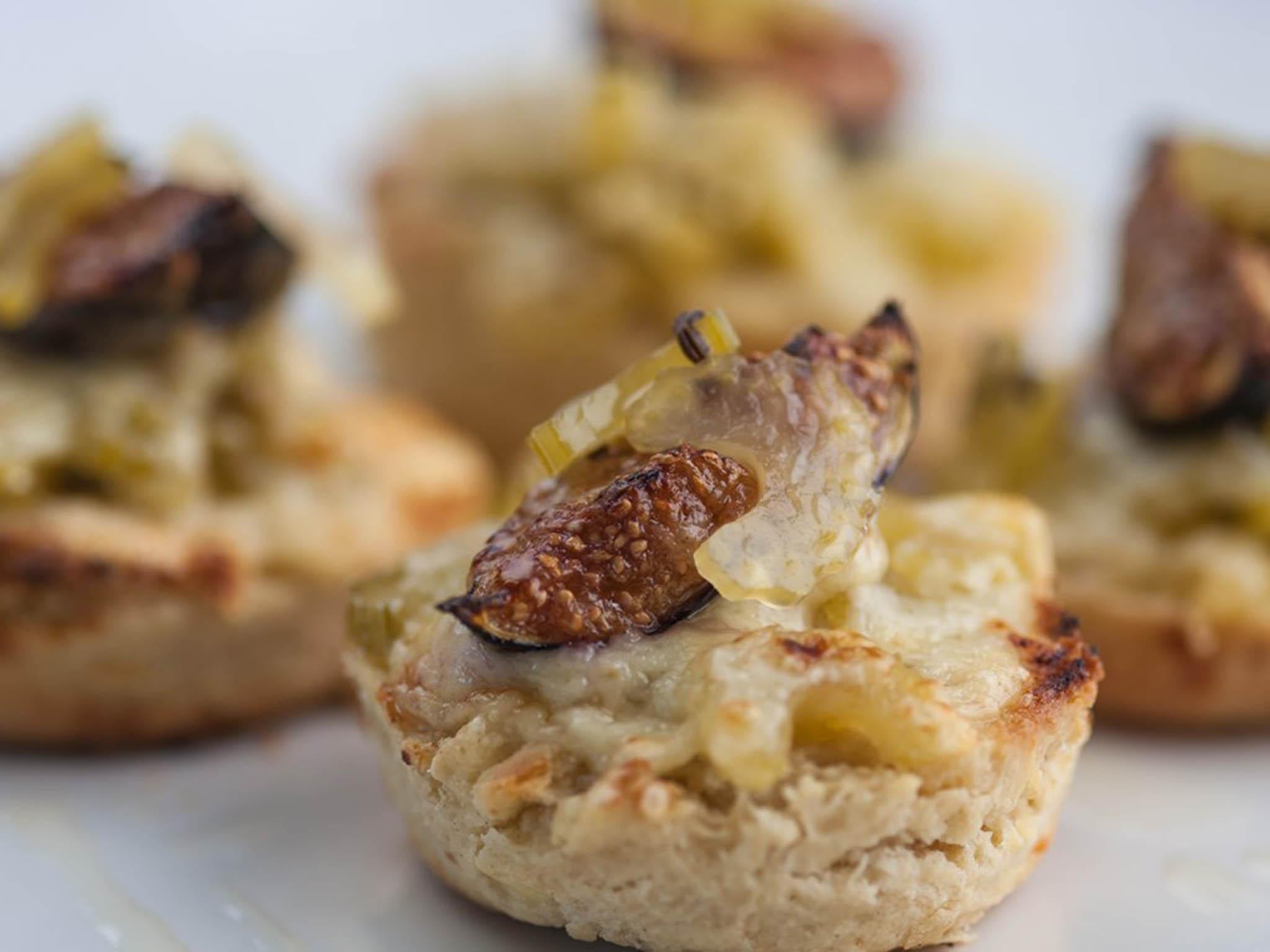
Nathan Outlaw is a household name when it comes to fish and seafood, but his cooking is so much more than that – he specialises in simple, honest food that values ingredients, regardless of where they come from. This little canape is no different – the simplicity allows the individual ingredients to shine, so make sure you have really ripe, fresh figs at the ready. The combination of savoury cheese scone, sharp pickled celery and slightly blackened figs is a beautiful one, with nothing else required.
Crackler cheddar scones
225g of self-raising flour, plus more for dusting
1 pinch of salt
55g of butter, cold and cut into small pieces, plus more for greasing
25g of cheddar, grated
150ml of milk, plus more to brush on scones
Pickled celery
1 head of celery, washed and sliced thinly
100ml of white wine
100ml of white wine vinegar
100ml of water
100g of sugar
30g of fennel seeds, toasted
1 pinch of salt
To plate
200g of cheddar, sliced
4 figs
salad leaves, to plate
olive oil, to drizzle
To make the cheese scones, heat the oven to 220°C/Gas mark 7. Lightly grease a baking sheet or cover the baking sheet with parchment paper. Mix together the flour and salt and rub in the butter. Stir in the cheddar cheese and then the milk to make a soft dough.
Turn on to a floured work surface and knead very lightly. Pat out to a round 2cm thick. Use a 5cm cutter to stamp out rounds and place on the baking sheet. Lightly knead together the rest of the dough and stamp out more scones to use it up. Brush the tops of the scones with a little milk. Bake for 12-15 minutes until well risen and golden. Cool cheddar scones on a wire rack.
For the pickled celery, place celery, white wine, vinegar, water, sugar, fennel seeds and salt into a sauce pan and bring to a simmer, uncovered, for about 2 minutes. Allow to cool and store the pickled celery in the fridge in an airtight container until ready to use. To plate, start by grilling the figs. Quarter the figs, then grill for 2-3 minutes.
Cut the scones in half. On the cut side, place a spoon of celery followed by some cheese. Place the figs on top of the cheese and then add a little more cheese. Grill the scones until the cheese starts to melt. Serve with a few salad leaves, a little olive oil and more pickled celery.
For more seasonal recipes, visit greatbritishchefs.com
Join our commenting forum
Join thought-provoking conversations, follow other Independent readers and see their replies
Comments